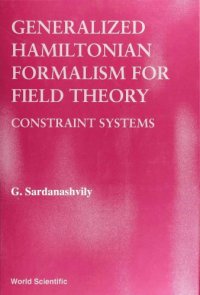Introduction -- 1. Geometric preliminary. 1.1. Fibred manifolds. 1.2. Jet spaces. 1.3. General connections -- 2. Lagrangian field theory. 2.1. Lagrangian formalism on fibred manifolds. 2.2. De Donder Hamiltonian formalism. 2.3. Instantaneous Hamiltonian formalism -- 3. Multimomentum Hamiltonian formalism. 3.1. Multisymplectic Legendre bundles. 3.2. Multimomentum Hamiltonian forms. 3.3. Hamilton equations. 3.4.
Analytical mechanics. 3.5. Hamiltonian theory of constraint systems. 3.6. Cauchy problem. 3.7. Isomultisymplectic structure -- 4. Hamiltonian field theory. 4.1. Constraint field systems. 4.2. Hamiltonian gauge theory. 4.3. Electromagnetic fields. 4.4. Proca fields. 4.5. Matter fields. 4.6. Hamilton equations of general relativity. 4.7. Conservation laws -- 5. Field systems on composite manifolds. 5.1. Geometry of composite manifolds. 5.2. Hamiltonian systems on composite manifolds. 5.3. Classical Berry's oscillator. 5.4. Higgs fields. 5.5. Gauge gravitation theory. 5.6. Fermion fields. 5.7. Fermion-gravitation complexIn the framework of the geometric formulation of field theory, classical fields are represented by sections of fibred manifolds, and their dynamics is phrased in jet manifold terms. The Hamiltonian formalism in fibred manifolds is the multisymplectic generalization of the Hamiltonian formalism in mechanics when canonical momenta correspond to derivatives of fields with respect to all world coordinates, not only to time. This book is devoted to the application of this formalism to fundamental field models including gauge theory, gravitation theory, and spontaneous symmetry breaking. All these models are constraint ones. Their Euler-Lagrange equations are underdetermined and need additional conditions. In the Hamiltonian formalism, these conditions appear automatically as a part of the Hamilton equations, corresponding to different Hamiltonian forms associated with a degenerate Lagrangian density. The general procedure for describing constraint systems with quadratic and affine Lagrangian densities is presented
Read more... 